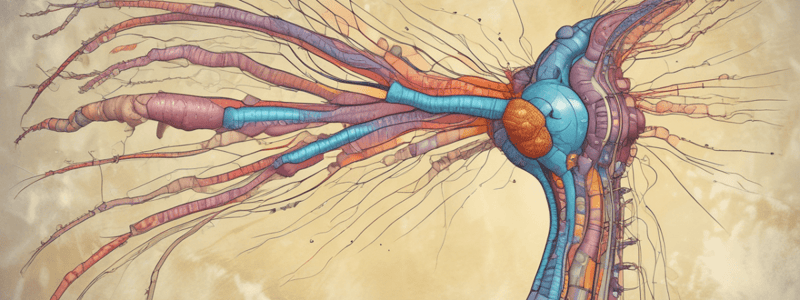Podcast
Questions and Answers
What type of neurotransmitter is released by moderate pain axons in the spinal cord?
What type of neurotransmitter is released by moderate pain axons in the spinal cord?
- Glutamate (correct)
- Substance P
- Glycine
- GABA
In which lamina of the dorsal horn do nociceptive axons synapse with second order neurons?
In which lamina of the dorsal horn do nociceptive axons synapse with second order neurons?
- Lamina III and IV
- Lamina I and III
- Lamina I, II, and V (correct)
- Lamina IV and V
What is the function of local inhibitory interneurons in the spinal cord?
What is the function of local inhibitory interneurons in the spinal cord?
- To release GABA and glycine (correct)
- To release glutamate and substance P
- To transmit moderate pain signals
- To synapse with second order neurons
What is the difference between transmission for moderate pain and stronger pain axons?
What is the difference between transmission for moderate pain and stronger pain axons?
What type of neurotransmitter is released by stronger pain axons, in addition to glutamate?
What type of neurotransmitter is released by stronger pain axons, in addition to glutamate?
What is the primary function of the release of glutamate by nociceptive axons in the spinal cord?
What is the primary function of the release of glutamate by nociceptive axons in the spinal cord?
Which of the following neurons are responsible for releasing GABA and glycine in the spinal cord?
Which of the following neurons are responsible for releasing GABA and glycine in the spinal cord?
What is the characteristic of the action of substance P and ATP released by stronger pain axons?
What is the characteristic of the action of substance P and ATP released by stronger pain axons?
In which lamina of the dorsal horn do nociceptive axons synapse with second order neurons involved in pain transmission?
In which lamina of the dorsal horn do nociceptive axons synapse with second order neurons involved in pain transmission?
What is the difference between the neurotransmitters released by moderate pain axons and stronger pain axons?
What is the difference between the neurotransmitters released by moderate pain axons and stronger pain axons?
Flashcards are hidden until you start studying
Study Notes
Synaptic Transmission of Pain Signals
- Nociceptive axons form synapses with second-order neurons in specific laminae of the dorsal horn in the spinal cord, namely lamina I, II, and V.
- Moderate pain transmission involves the release of glutamate from axons, resulting in fast action.
- Stronger pain transmission involves the release of both glutamate and substance P (and ATP) from axons, resulting in slower and sustained actions.
- Local inhibitory interneurons play a regulatory role by releasing GABA and glycine, which counteract the excitatory effects of pain transmission.
Synaptic Transmission of Pain Signals
- Nociceptive axons form synapses with second-order neurons in specific laminae of the dorsal horn in the spinal cord, namely lamina I, II, and V.
- Moderate pain transmission involves the release of glutamate from axons, resulting in fast action.
- Stronger pain transmission involves the release of both glutamate and substance P (and ATP) from axons, resulting in slower and sustained actions.
- Local inhibitory interneurons play a regulatory role by releasing GABA and glycine, which counteract the excitatory effects of pain transmission.
Studying That Suits You
Use AI to generate personalized quizzes and flashcards to suit your learning preferences.



